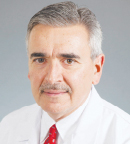Data from the TAILORx study and several National Surgical Adjuvant Breast and Bowel Project (NSABP) trials have been used to develop a new prognostic tool, RSClin, which aims to individualize the estimate of recurrence risk in early breast cancer and to more accurately predict the risk-reduction benefit of adjuvant chemotherapy.
RSClin was described at the 2020 San Antonio Breast Cancer Symposium by lead researcher Joseph A. Sparano, MD,1 of Montefiore Medical Center, Albert Einstein College of Medicine, Bronx, New York, and a report on the tool was concurrently published in the Journal of Clinical Oncology.2

“We found that … the estimates of risk by RSClin closely approximated the actual distant recurrence rates in the real-world cohort.”— Joseph A. Sparano, MD
Tweet this quote
“RSClin was shown to provide more prognostic information than either recurrence score used alone or clinical-pathologic features used alone. This tool is now available for use by health-care professionals on the Genomic Health website (https://online.genomichealth.com), and we hope it will assist clinicians in conducting shared decision-making discussions with their patients,” said Dr. Sparano.
About RSClin
RSClin integrates the 21-gene recurrence score with tumor grade, tumor size, and age. It was developed using data from a patient-specific meta-analysis of 10,004 women with hormone receptor–positive HER2-negative, node-negative breast cancer. This database included, from the NSABP B-14 study,3 577 women who received endocrine therapy alone and, from TAILORx, 4,854 who received endocrine therapy alone and 4,573 who also received chemotherapy.4
Cox models for RSClin were compared with the 21-gene recurrence score alone and clinical-pathologic features alone using likelihood ratio tests. RSClin estimates of distant recurrence used a baseline risk with TAILORx event rates to reflect current medical practice for node-negative breast cancer. A patient-specific estimator of absolute chemotherapy benefit was computed using individualized relative chemotherapy effect from patients with a recurrence score of 11 to 25 randomized to chemotherapy in TAILORx, plus patients with any recurrence score randomized to chemotherapy in the NSABP B-20 trial.
External validation of risk estimation was performed by comparing RSClin estimated risk and observed risk in 1,098 women in the “real-world” Clalit Health Services registry from Israel, in which recurrence score was used as a component of standard of care to inform treatment of node-negative breast cancer.5 Dr. Sparano noted that the patients in the registry were very similar to the cohort used to develop RSClin. “As expected, most of the chemotherapy was administered to patients with high recurrence scores,” he noted.
KEY POINTS
- A new prognostic tool, RSClin, may help individualize the estimate of recurrence risk in early breast cancer and more accurately predict the risk-reduction benefit of adjuvant chemotherapy.
- RSClin integrates the 21-gene recurrence score with tumor grade, tumor size, and age. It was developed using data from a patient-specific meta-analysis of 10,004 women with hormone receptor-positive HER2-negative, node-negative breast cancer.
Among all 10,004 patients in the meta-analysis cohort, RSClin provided more prognostic information for distant recurrence than recurrence score alone (P < .001) or clinical-pathologic factors alone (P < .001), Dr. Sparano reported.
In external validation using the Clalit registry, RSClin risk estimates were significantly associated with an observed risk of distant disease recurrence (hazard ratio [HR] = 1.73; P < .001). Within each risk quintile, the average 10-year risk estimate by RSClin approximated the Kaplan-Meier estimate in the cohort, with a Lin concordance correlation of 0.962. As in the meta-analysis cohort, RSClin provided more prognostic information in the external validation cohort than either recurrence alone (P = .004) or clinical-pathologic factors alone (P = .027).
“We found that RSClin did provide prognostic information for distant recurrence and, secondly, that the estimates of risk by RSClin closely approximated the actual distant recurrence rates in the real-world cohort,” he said.
Example of Benefit
In the publication, Dr. Sparano and his colleagues gave two examples that simulated the absolute benefit estimates associated with chemotherapy in clinical low-risk and clinical high-risk subjects, as defined in TAILORx.
Using RSClin for a 55-year-old woman with a clinical low-risk 1.5-cm intermediate-grade tumor and negative lymph nodes, the absolute chemotherapy benefit estimate ranges from 0% to 15% as the recurrence score ranges from 11 to 50; this compares with a range of 2% to 8% if the relative chemotherapy benefit did not vary by recurrence score and was held constant. Over the same recurrence score range for a 55-year-old woman with a clinical high-risk 2.5-cm poor-grade tumor and negative lymph nodes, the tool’s absolute chemotherapy benefit estimate ranges from 1% to 33%, compared with 4% to 17% if the relative chemotherapy benefit was held constant.
This indicates that the incremental chemotherapy benefit observed with higher recurrence scores is driven not only by a higher underlying recurrence risk but also by the prediction of greater relative risk reduction with chemotherapy, the authors said.
DISCLOSURE: Dr. Sparano has served in a consulting or advisory role for Adgero Biopharmaceuticals, AstraZeneca, Cardinal Health, Celgene, Celldex, CStone Pharmaceuticals, Daiichi Sankyo, Epic Sciences, Genentech/Roche, GlaxoSmithKline, Juno Therapeutics, Lilly, Merrimack, Novartis, Pfizer, and Prescient Therapeutics; has received institutional research funding from Deciphera, Genentech/Roche, Merck, Merrimack, Novartis, Prescient Therapeutics, and Radius Health; and has been reimbursed for travel, accommodations, or other expenses by Adgero Biopharmaceuticals, AstraZeneca, Menarini Silicon Biosystems, Myriad Genetics, Pfizer, Rhenium Medical, and Roche/Genentech.
REFERENCES
1. Sparano JA, Crager MR, Tang G, et al: Development and validation of a tool integrating the 21-gene recurrence score and clinical-pathological features to individualize prognosis and prediction of chemotherapy benefit in early breast cancer. 2020 San Antonio Breast Cancer Symposium. Abstract GS4-10. Presented December 11, 2020.
3. Fisher B, Costantino J, Redmond C, et al: A randomized clinical trial evaluating tamoxifen in the treatment of patients with node-negative breast cancer who have estrogen-receptor-positive tumors. N Engl J Med 320:479-484, 1989.
4. Sparano JA, Gray RJ, Ravdin PM, et al: Clinical and genomic risk to guide the use of adjuvant therapy for breast cancer. N Engl J Med 380:2395-2405, 2019.
5. Stemmer SM, Steiner M, Rizel S, et al: Ten-year clinical outcomes in N0 ER+ breast cancer patients with recurrence score-guided therapy. NPJ Breast Cancer 5:41, 2019.



